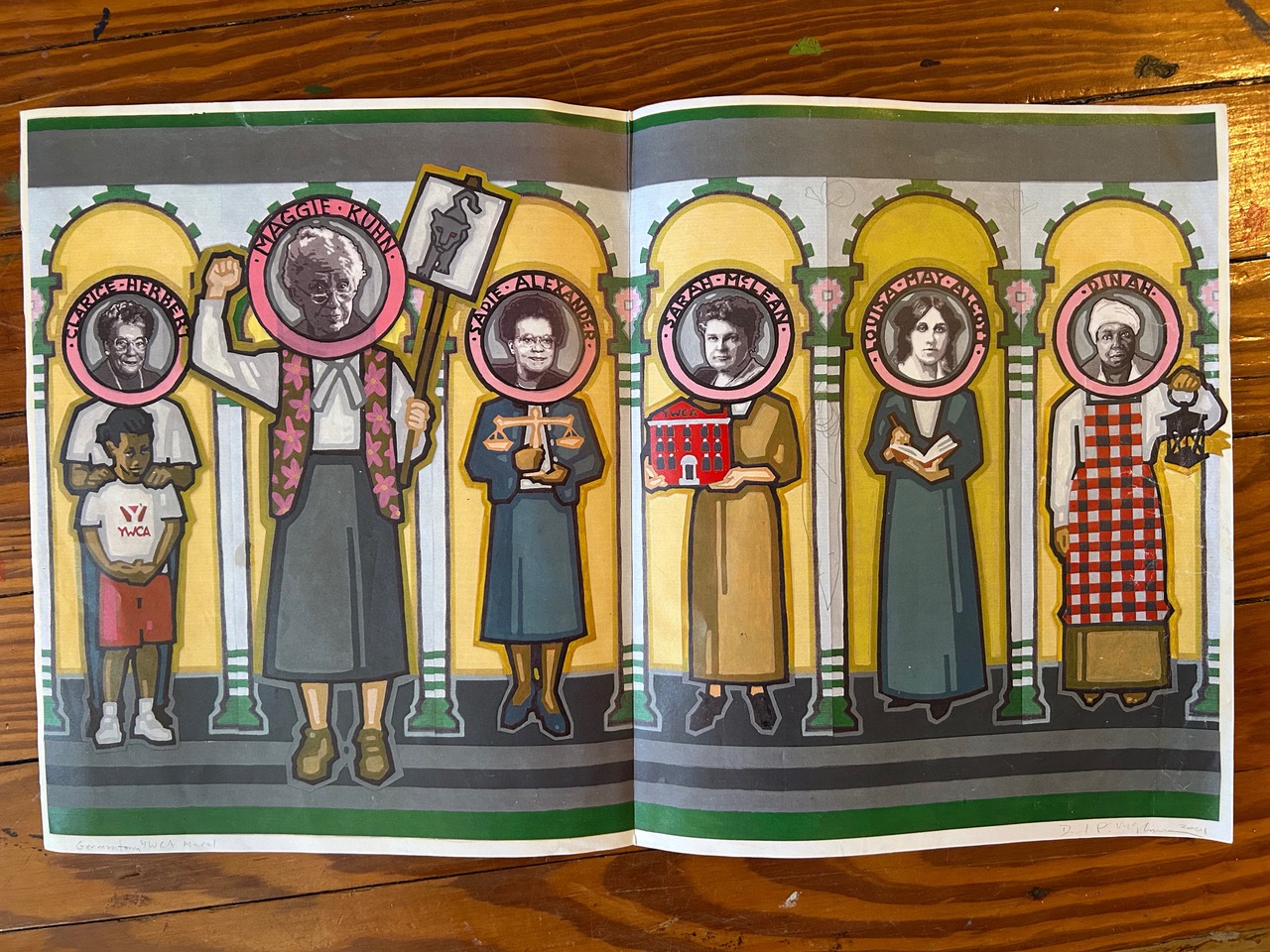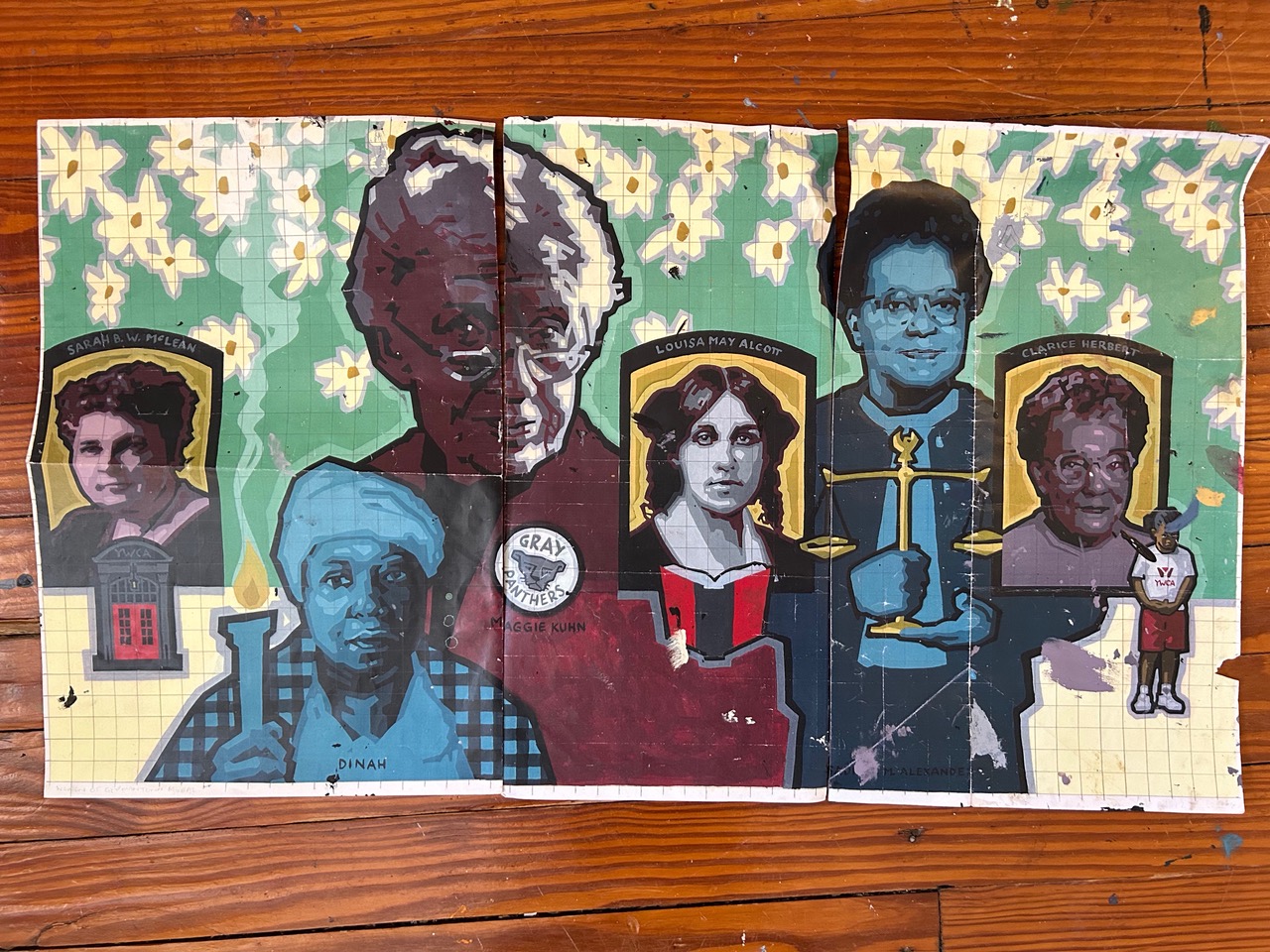The Women of Germantown Mural
Estrella Pacheco and Krista Chan
Uncovering and Rediscovering the Women of Germantown Mural
On the side of the Germantown YWCA is a large mural with the faces of six women, Maggie Kuhn, Louisa May Alcott, Sadie Tanner Alexander, Sarah B.W Warden McLean, Clarice Gamble Herbert, and Dinah. The mural was completed in 2001 by artist David McShane and was appropriately named The Women of Germantown. All of these women depicted on the mural have ties to Germantown and some to the Y itself.
While the mural itself is easily accessible for the public to view on the side of 5280 Germantown Ave, understanding the history and origins of the mural has been a lot less accessible. Students at Bryn Mawr and Haverford have begun to uncover the story behind the mural and the women it memorializes.
Uncovering The Murals Origins
This detective work started with emailing the most obvious people: the artist, David McShane, and Mural Arts Philadelphia. Mural Arts Philadelphia had no records of the mural other than the finished product. David McShane was able to talk to us and gave us his account of how he got involved with the mural.
Students reached out to Sue Leary, Maggie Kuhn’s personal assistant and a donor for the mural. According to Leary, she recalls the mural beginning as a project that was meant to memorialize Maggie Kuhn and her legacy, which aligns with the notes given to us by Dave McShane, the mural’s lead artist, as well. Working with other colleagues and friends of Kuhn’s, they decided to create a mural on the side of the Germantown YWCA, a place where Maggie Kuhn once worked and had a strong connection to. While discussing the logistics of the mural, Leary and the others realized that Maggie never flew solo and thought it would be best to add other important and impactful women to the mural.
In notes shared with students, Dave McShane reveals that the mural’s origins were community-engaged and collaborative in nature with Germantown Y members advocating for their vision. While Dave was initially under the impression that the mural had been commissioned to honor Maggie Kuhn, founder of the Gray Panthers and influential leader at the Germantown YWCA, after meeting with the Y’s mural committee the plan quickly changed. The YWCA mural committee had come up with a list of 50 or so women of Germantown compiled and researched by local Germantown historian, and former Germantown Crier editor, Judith Callard. The mural committee hoped to honor all 50 women, who had been instrumental to the history of Germantown!
“We reached a compromise: six women would have their portraits in the mural, and the rest of the list would have their names included at the bottom of the mural.”
— Dave McShane
Pamphlets featured below reveal that the Y was creating curriculum that they hoped to have taught in Germantown schools about the 42 women whose likeness or names appear on the mural. The newsletter also mentions a potential book, likely related to the research of Judith Callard. The newsletter calls for recommendations of more women to include, listing its only requirements to be that they lived in Germantown and/or contributed to the community at one point or another. A list of the 42 names listed can be found here: The Women of Germantown.
The Mural Design
With input from the Y’s mural committee the final version of the mural was designed and then painted onto the wall. The design features the six key women on a colorful and floral background which, according to Dave McShane, “represents the seeds of these women’s works blossoming and being passed on to current and future women of Germantown to appreciate and to carry on.” Each of the women is depicted with a symbol representative of their contribution to the community and broader society. Sarah B.W. McLean, who funded the Y’s building is represented with the entrance to the Y, Dinah is represented with a torch, Maggie Kuhn is represented with a large Gray Panthers button, Louisa May Alcott is represented by a book, Sadie Tanner is featured with scales of justice, and Clarice Herbert’s symbol is two girls of different races which represent the Y’s historical precedence in integration and its racially diverse community.
Beyond the Mural: Community Involvement
While these testimonies give great insight into the early stages of the mural, pamphlets found at Germantown Historical Society have created more questions about the inception of the mural.
According to a Germantown Women’s Y pamphlet released in fall of 2000, there was a program titled “The Big Picture – Mural Arts for Teens”. The program was supposed to run from October 2nd, 2000, until June 16th, 2001. The program was divided up into three phases. The first phase was meant to teach the basics of drawing, composition, space, and color. The second is where students were introduced to the process of creating a mural, and were taught lessons on teamwork, conflict resolution, and social responsibility. The last phase was the actual creation of a mural. Students were meant to select a wall, develop a sketch, and gain approval for their intended mural. In the pamphlet, the listed instructor was Jane Degenhardt, an artist associated with Mural Arts Philadelphia.
The same pamphlet that advertised “The Big Picture” program also had another page that revealed the “Women’s Mural”. In the pamphlet it says that the mural will be done by Jane Degenhardt and will be designed as a “‘Crazy Quilt’ pattern of the Germantown region and the history of the Y”. The project was also said to be postponed until the spring of 2001.
When the mural project finally got up-and-running again the Big Picture Mural Program allowed 10 kids from the area aged 10-15 to help prime and paint the mural between July and August of 2001. Dave McShane also had the help of student assistants Greg Long, whose mother Christina Long helped write Maggie Kuhn’s autobiography, and Katie Hubbard whose mother Antonette Berger was the Y’s executive director at the time.
While the YWCA was not the conception point for the mural, it was readily identified as a space of importance in fostering and bringing together important community leaders, artists, activists, and other women in Germantown. Thus, it became an ideal spot to host a mural in their honor.
The mural’s origin story is a true testament to the nature of the Germantown community. The project brought together people with various ties to Germantown, to honor the women who have helped shape the community throughout history.
The Mural Dedication
The mural was finished in August 2001. Clarice Gamble Herbert, the only living woman honored on the mural, was in attendance along with Irma Gardner-Hammond who posed for the portrait of Dinah.
If you have any further information on this mural project or the women featured on it we invite you to share it with us by emailing _______.



